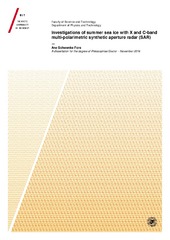Investigations of summer sea ice with X and C-band multi-polarimetric synthetic aperture radar (SAR)
Permanent link
https://hdl.handle.net/10037/10723View/
Thesis (PDF)
Paper 1: Fors, A. S., Brekke, C., Doulgeris, A. P., Eltoft, T., Renner, A. H. H., Gerland, S.: “Late-summer sea ice segmentation with multi-polarisation SAR features in C and X band”. Also available in The Cryosphere 2016, 10:401-415. (PDF)
Date
2017-03-17Type
Doctoral thesisDoktorgradsavhandling
Author
Fors, Ane SchwenkeAbstract
In this thesis, we explore the possibilities and limitations of using space-borne multi-polarimetric SAR in summer sea ice investigations. Both X and C-band data are examined. The study utilizes two data sets collected in the Arctic in 2011 (Fram Strait) and 2012 (north of Spitsbergen). Both sets combine satellite SAR scenes with co-located ground and air-borne measurements.
Firstly, the study explores the summer sea ice type discrimination ability and temporal consistency of six polarimetric SAR features, and test an automatic segmentation algorithm based on the features. The algorithm succeed in segmenting the C-band SAR scenes into different sea ice types, but show poor performance in X-band. To develop the segmentation into a classification, labeling the segments, more information about how the polarimetric SAR features relate to sea ice properties is needed. The SAR signatures of two such properties, sea ice surface roughness and melt pond fraction, are therefore further investigated.
Several C-band polarimetric SAR features are found related to sea ice macro-scale surface roughness in the study, but the relationships are sensitive to incidence angle, meteorological conditions, and changes in micro-scale surface roughness. The findings differ from previous studies in other seasons, demonstrating that SAR sea ice surface roughness signatures changes with season and sea ice type.
Relationships between melt pond fraction and several X-band polarimetric SAR features are also demonstrated. Wind speed and SAR incidence angle are found to have a large impact on these results. The findings could imply a future potential of X-band melt pond fraction estimation with SAR, but this requires more advanced methods and an increased number of satellite scenes.
Our study demonstrates new possibilities in segmentation and characterization of Arctic summer sea ice with multi-polarimetric satellite SAR. The findings contribute in the development of improved monitoring techniques for sea ice in a rapidly changing Arctic, increasing the safety of human activities and research in the ice-covered seas.
Description
The papers 2 and 3 of this thesis are not available in Munin.
Paper 2: Fors, A. S., Brekke, C., Gerland, S., Doulgeris, A. P., Beckers, J. F.: "Late Summer Arctic Sea Ice Surface Roughness Signatures in C-Band SAR Data". Available in IEEE Journal of Selected Topics in Applied Earth Observations and Remote Sensing 2016, 9(3):1199-1215.
Paper 3: Fors, A. S., Divine, D. V., Doulgeris, A. P., Renner, A. H. H., Gerland, S.: «Signature of Arctic first-year ice melt pond fraction in X-band SAR imagery”. (Manuscript).
Paper 2: Fors, A. S., Brekke, C., Gerland, S., Doulgeris, A. P., Beckers, J. F.: "Late Summer Arctic Sea Ice Surface Roughness Signatures in C-Band SAR Data". Available in IEEE Journal of Selected Topics in Applied Earth Observations and Remote Sensing 2016, 9(3):1199-1215.
Paper 3: Fors, A. S., Divine, D. V., Doulgeris, A. P., Renner, A. H. H., Gerland, S.: «Signature of Arctic first-year ice melt pond fraction in X-band SAR imagery”. (Manuscript).
Publisher
UiT Norges arktiske universitetUiT The Arctic University of Norway
Metadata
Show full item recordCollections
Copyright 2017 The Author(s)
The following license file are associated with this item:


 English
English norsk
norsk
